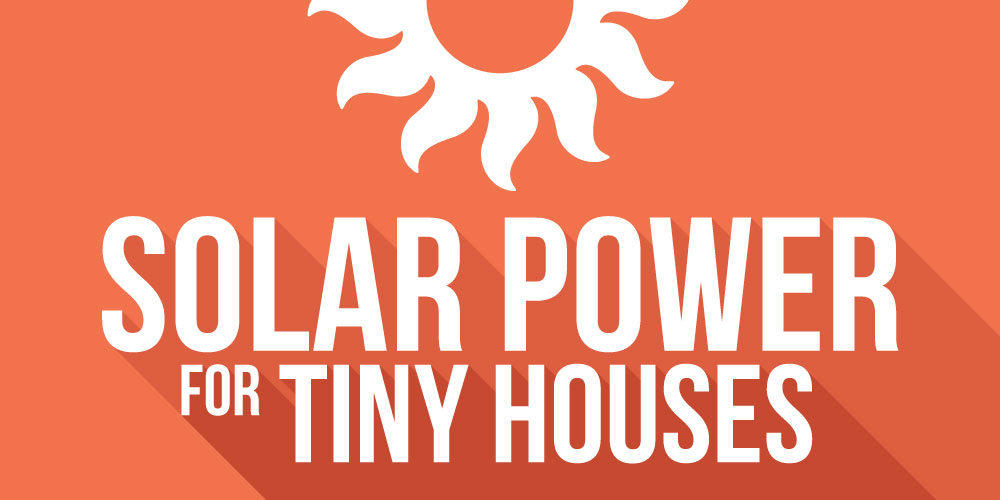
It’s hard to imagine that I’ve been powering my tiny house off solar panels for my tiny house for over 7 years now! Not having a power bill for almost a decade has been incredible. With that in mind, I wanted to get some real-world experience with my system to give you all the full picture of what it’s really like to power your tiny house with solar: how many panels, how much does it cost, and more.
Solar Panels For A Tiny House

Many people have asked me about putting solar panels on a tiny house because I’m one of the few out there that is totally off the grid in my tiny house. I’ve had to figure things out like how to run my air conditioning off solar, how to cook with solar in a solar oven, and how I use solar generators as backup power in a pinch.
Tiny houses are a great candidate for solar power because the smaller space makes 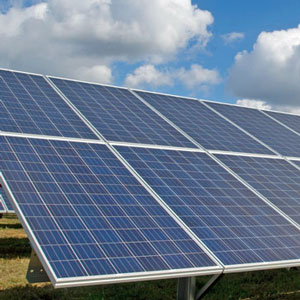 for low power needs. While the traditional home in America uses around 30 KWs per day, my tiny house uses around 3 KWs per day.
for low power needs. While the traditional home in America uses around 30 KWs per day, my tiny house uses around 3 KWs per day.
Every decision I made during my tiny house build, from choosing LEDs lights, to a super-efficient minisplit system, and an on demand hot water heater all were chosen to reduce my power consumption. Since I built my own house, these decisions were pretty simple and, in the end, didn’t cost me much more. Any additional costs for things like a high SEER rating HVAC system quickly paid for themselves by letting me have a smaller solar panel array and batteries.
How Much Power Does A Tiny House Use?
A tiny house will use around 4 KWs per day. Typically, around 80% of that power will be used for heating and cooling, assuming you cook and heat water with propane or natural gas.
Here is an example of my power usage breakdown:
- Minisplit (heating/cooling): 3,000 watts per day
- Fridge: 780 watts per day
- Lights: 100 watts per day
- Cell Phone: 30 watts per day
- Laptop: 240 watts per day
Total: 4,150 watts per day
How Many Panels Do You Need To Power A Tiny House?

15 solar panels will power a typical tiny house. This assumes an average sized solar panel of around 300 watts, which would generate around 4,500 watts of power from the sun. This would cover all your power needs including some heating and cooling, but require you to have a gas cook range and a propane heated hot water heater. If you live in a particularly cold climate, you’ll most likely need to supplement your heating with a propane heater too.
How many solar panels can you fit on a tiny house roof?

Generally speaking, you can only fit around 2 solar panels on a tiny house roof. This presents a real challenge because today you can really only expect to make around 20 watts per square foot of solar panel in ideal circumstances. That means you’re only going to be able to fit around 600 watts of solar production on a tiny house roof, which isn’t a whole lot.
Mounting Solar Panels On A Tiny House Roof

Many people want solar panels on the roof of their tiny house, but I opted for a ground mounted solar array, which I highly recommend. Tiny house roofs only have around 200 square feet of space and since most roofs are pitched, you can really only mount panels on one side. This means you only have around 100 square feet of space for panels.
What I did was mount my solar panels on stands on the ground. After considering all the options: roof mounted, pole mounted, solar trackers, and fixed ground mount, I’m really happy with my decision.
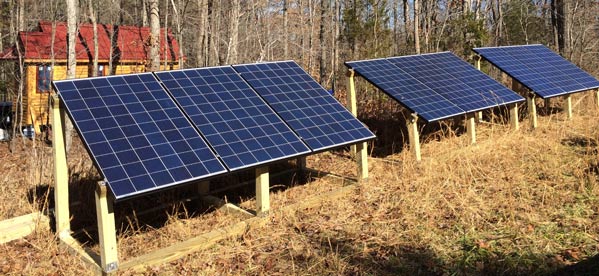
The benefits of a ground mounted array are huge: being able to easily clean my panels, clear off snow that covers my panels after a snow fall, keeping the panels cooler (increases their efficiency) and being able to shade my house while placing the panels in an open field.
The biggest benefit of ground mounting my panels is that I could have a way bigger solar panel array. This meant instead of 600 watts on the roof of my tiny house, I could put 4,000 watts on the ground in the field right next to my tiny house.
My Tiny House Solar Panel System:

To get your tiny house setup on solar you’ll need the following parts: your panels, batteries, a charge controller and an inverter. Simply put, your solar panels take the energy from the sun an converts it to DC power, that then flows to the charge controller which regulates the flow of power to the batteries or the inverter, the batteries stores power for later and the inverter converts the DC power to AC power, which your house uses.

Here’s the key details of my solar power system:
- 3,975 (3.9 KW) of panels Schneider SW 4024 – fifteen, 265 watt panels
- 1,110 amp/hr battery storage
- 24 volt system
My Tiny House Solar Setup:
- (15) Canadian Solar CS-6p 265 Watt Poly Black Frame
- Schneider SW 4024 Inverter
- Schneider MPPT 60 Charge Controller
- (12) Trojan L-16 6v 370 AH Flooded Lead Acid Batteries
- Schneider System Control Panel
- Schneider Interconnect Panel
- Midnight Solar MNPV 80AMP Dinrail Breaker
- Midnight Solar Surge Protection Device AC/DC
- 50 Amp RV power Inlet
How To Build A Solar Power System For Your Tiny House

Before anything I needed to determine the best placement for the solar panels to make sure it had good solar exposure and didn’t fall into shadows too much. To do this I used a tool called a “solar path finder” which is a semi reflective dome that you position at the location, then snap a photo.
The photo is then loaded into a program and spits out a whole bunch of calculations.
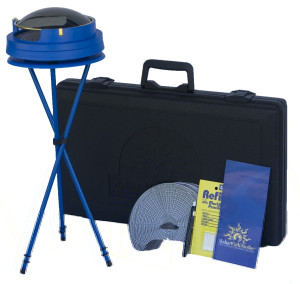
Calculating Power Production

Once you upload the image into the software and then trace the tree line outline, you enter in your location, date and time. It then can calculate how much power you’ll produce based on 30 years of weather patterns for your exact location and tree coverage. Then it spits out all the calculations:
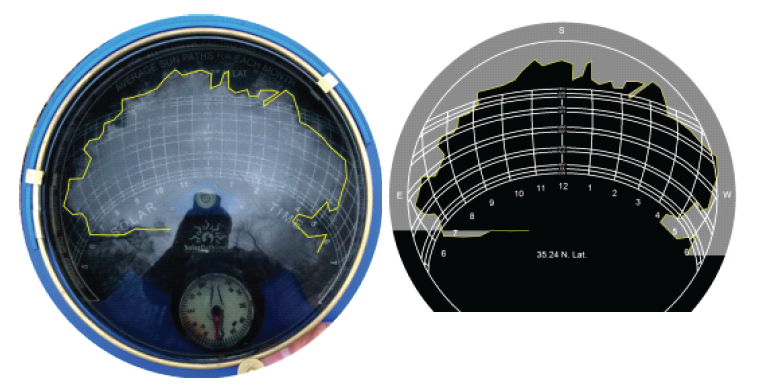
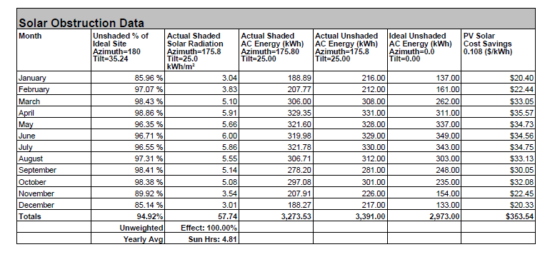
With that in mind, I knew what I could expect out of the system I had designed. It also was a way to verify my assumptions.
Once I verified that the system was going to be well suited to my needs, I had to build my panel support racking. I did this out of pressure treated 4×4’s that were each 10′ long. These things about 300 lbs each so I don’t have to worry about the wind picking up the panels.
I opted to build them because it was cheaper than some of the turn-key option out there and most of the for purchase ones required me to cement in the ground; I rent my land, so I wanted a mobile solution. If I remember correctly it was about $500 in materials to build this part.
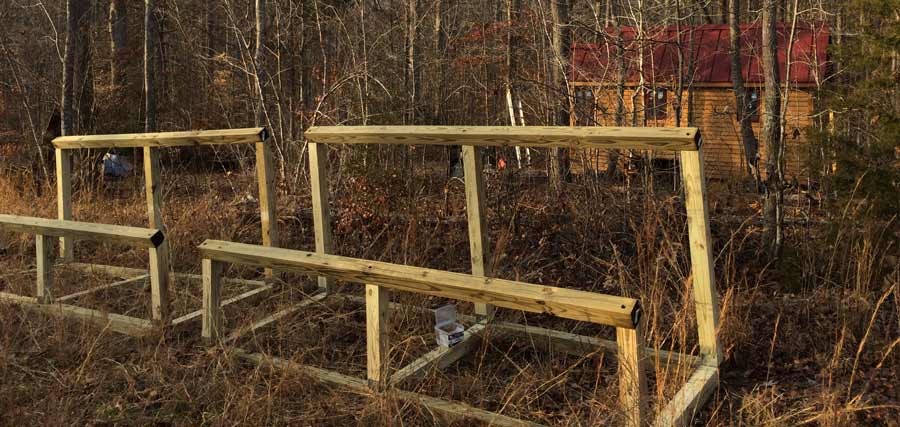
Many people have asked why I didn’t mount these on my tiny house roof. You technically can mount on your roof, but honestly, the number of panels that you need to practically power your house is too many for the roof.
There are some other major bonuses of being on the ground:
- Much cooler, roofs are very hot places in the summer and solar panels drop in efficiency when hot
- I can put my house under deciduous trees, this means in summer I’m in the shade, in winter I get the solar gain
- Way easier to clean and monitor
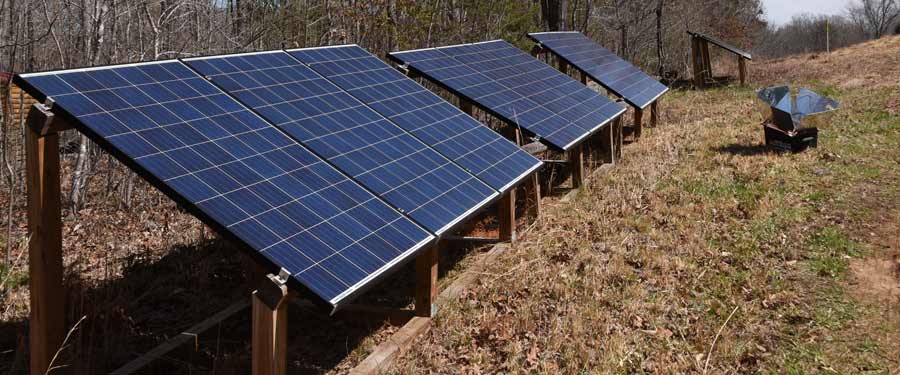
Cleaning your panels is pretty important because you loose efficiency as residue (bird poop) builds up. Also, as I learned just a few days ago, when it snows, you need to clear your panels. Cleaning becomes super simple and a lot safer when you don’t have to climb onto a roof via a ladder.
Just this week we got a decent snow, 3 inches, which is quite a lot for Charlotte. The first thing I had to do when I woke up was clear off the panels because, with the snow, they made no power. This was compounded because since it was cold, I needed more heat. I can’t imagine having to drag the ladder out and try climbing on an icy roof… No Thanks.
Choosing To Wire For AC Or DC From Solar

Many people have read around the internet that DC (direct current) is a more efficient power way to power things. Generally speaking, everything in a traditional house is wired for AC (alternating current), but if you’re putting solar in a tiny house and building your own house, the question becomes relevant when you’re starting from scratch. Solar panels produce DC power, so you have to decide how you’re going to handle it.
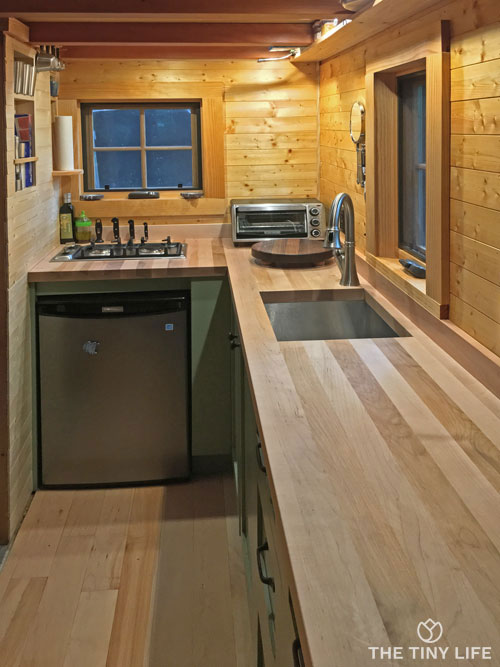
Most of the advice to wire a house for DC power comes from older sources who haven’t updated; these could be old articles written on the topic (consider anything more than a year out of date with how fast solar is improving) or from someone who hasn’t caught up with the latest equipment.
Back in the days, the drive to wire a house in DC power comes from two main things: there was power loss through inefficient inverters (converts from DC to AC) and from the fact that on paper DC is, in fact, more efficient.
Where this falls down in modern times is that inverters have come a long way and while there is some loss in power through the converting of AC to DC, it’s quite minimal. The other factor here is that any inefficiencies (of both the conversion to AC and the less efficient nature of AC) can be easily offset by the addition of 1-2 panels to your array.
This begins to make even more practical sense today because if you wire for DC, you’ll be limited to DC powered appliances, which typically cost two to three times the cost of their AC equivalents. That all means that you can actually have more power with AC, even after the losses through inefficiency, for less money. This is because the savings from going to AC appliances over DC will leave you with more cash, even after you buy 1-2 more panels.
To put it simply, convert to AC, add a few more panels to your array and stop worrying about AC vs DC.
Installing Solar Panels For My Tiny House

After calculating the ideal location and building my stands, I installed the solar panels. This part was pretty quick and the stands worked out perfectly. The panels are 250 watt Canadian solar panels. They are wired in groups of three, then paralleled into the system. To give you a sense of scale, these panels are 3.3 wide and about 4 feet tall.
Building My Battery And Inverter Cabinet

Next, I built a cabinet to house all the gear. I wanted a stand alone space because the batteries are so heavy. At 118 pounds each, plus cabling and other equipment, the whole unit is over 1,100 lbs. The top and bottom sections are divided so that the gasses from the batteries don’t go up into the electrical section for a very important reason.
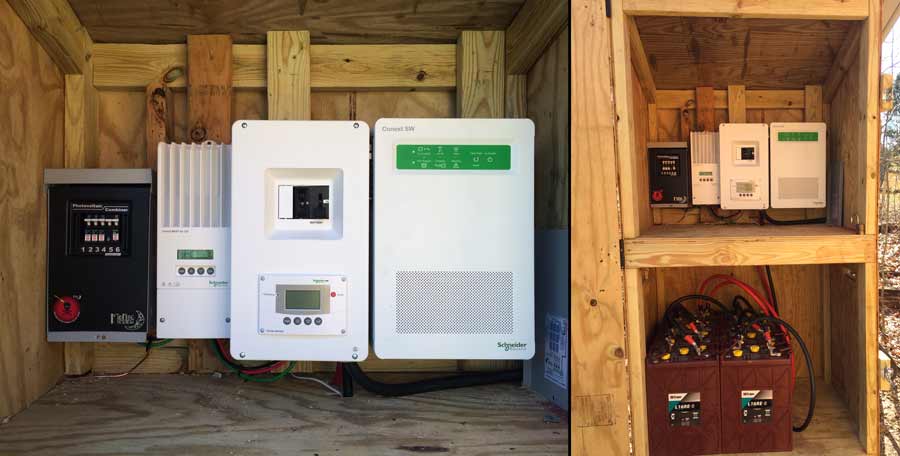
Looking at the cabinet, on the sides of it, you can see the vents. When you use lead acid (LA) batteries you have some off gassing as the batteries discharge and recharge. These gasses are volatile and can ignite, possibly leading to an explosion. To take care of this I installed two vents like this which provide adequate venting.
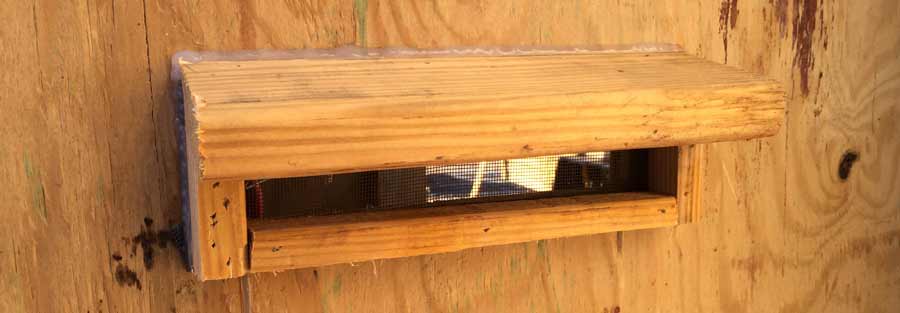
Choosing Batteries For A Tiny House Solar Panel System

I choose lead acid batteries over AGM (absorbent glass mat) because LA’s have more cycles and cost a bit less. Lithium Ion at this point is cost prohibitive, around $10,000 for the equivalent capacity. I choose these 6 volt batteries because it was more economical over other options and trojan is a pretty reputable name in the industry.
My batteries should get about 4000-5000 cycles (11-14 years) before I need to replace them. I figure in about 5 years battery technology will have progressed so much I’ll change early. New batteries will cost me about $5,000 of the lead acid variety.
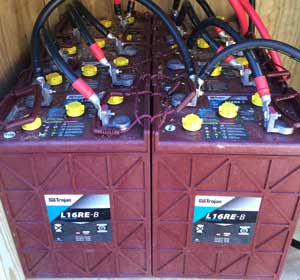
Wiring My Batteries For 24 Volts

The batteries are wired in series parallel. The batteries are 6 volt each, in series of 4 the create a 24 volt unit. Then I have two of these 24-volt units in parallel. The reason I choose to go 24 volts over a 48 volt (which is more efficient) was that the equipment was a little cheaper and it allowed me to future proof my setup.
Future Proofing My Solar Panel System

Going with a 24 volt system also allowed me to select components that I could add more panels and batteries very easily without doing equipment upgrades (just a factor of the abilities of the units I choose). This way I can add up to 15 panels and a lot more batteries without upgrading the electronics. A big draw for me to the system I choose was that I can also stack these inverters, so if I ever go to a normal sized house, I just add another unit and it just plugs into my current one.
Wiring A Tiny House For Solar

In this photo going left to right: Din Breaker Panel, Charge Controller, Interconnect w/ control panel, inverter.
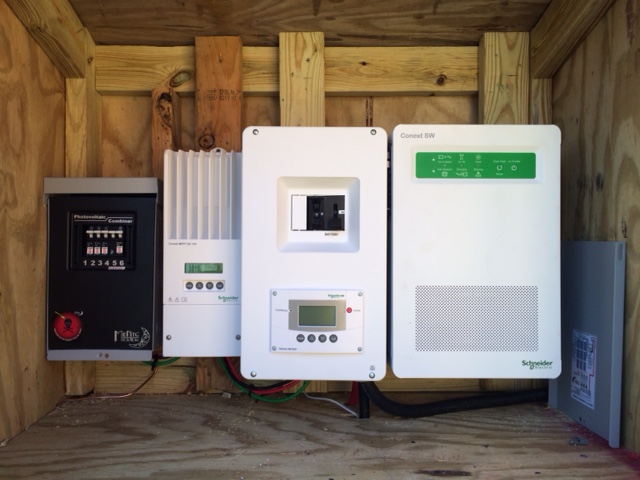
In general, the power flows in the same manner (but not exactly).
- Breaker Panel: manages power from solar panels
- Charge Controller: manages power to batteries etc.
- Interconnect: a main junction box and breaker, holds control panel interface
- Inverter: takes power in many forms then outputs to the type of power you need
How To Connect Solar To A Tiny House

Once the power goes through the system it outputs from the inverter as AC power. This AC Power flows out through a huge cable that you can see sticking out of the bottom of the inverter then goes right. From there it runs to this:
This is a 50 amp RV style plug. The reason I did this was twofold. City inspectors are less picky when it comes to non-hard-wired things. This setup also lets me roll into any RV campground and hook up seamlessly.
The plug goes into a 50 amp RV female receptacle. This is important that you don’t have two male ends to your cord. This is dubbed by electricians as a “suicide cord” because if you plug into a power source, you have exposed conductors that are live; accidentally touch them, you complete the circuit and zap!
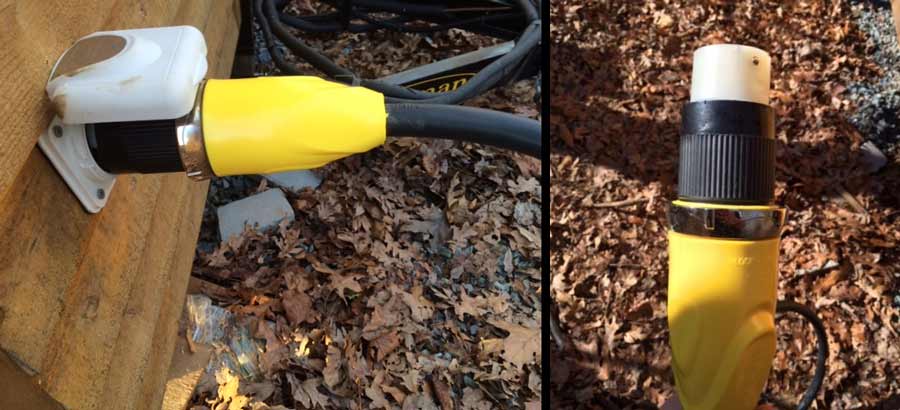
You want a female end to your cord so that you reduce the chance of being shocked. I also turn off my main breaker at the power source when I make this connection, then turn it back on.
If all these mentions of watts, volts, amps, amp hours etc are making your head spin a little, you may need to go back to the basics. I have an ebook called Shockingly Simple Electrical For Tiny Houses which guides you through all the basics. As of now, it doesn’t go too deep into the solar aspects, but the basics of electrical, wiring, power systems and determining your power needs are covered in depth and designed for those who are totally new to the topic.
So once the power passes through the power inlet it goes to the panel. Near the bottom you can see the backside of the power inlet, it has a large black cord coming out of it, into the box and ties to the lugs. From there it goes out to the house.
Grounding Your Solar Array

Here is my grounding wire for my system. This is actually one of two, another is located at the panels themselves. My house is also grounded to this through the cable hook up and to the trailer itself.
A really important note: ground depends on a lot of things, one of which is if you house electrical panels is bonded or not, if you don’t know what that means, read up on it, it’s very important.
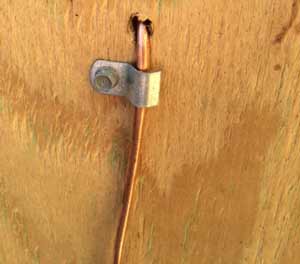
Using A Backup Generator

The other component of this system is the generator which I used for the first two years and then opted to upgrade my system because they were such a pain to use. In the winter months, I sometimes needed to top off my batteries every now and then, basically when it’s been really cold and very cloudy for a week or more.
I had a Honda EB2000i already which I really like. It’s very quiet and small. The one downside to the Honda is that it only does 1600 watts and only 120V and I needed more power and 240V. To charge my batteries, I had to have 240 Volts, which lead me to get another generator, a 5500 watt 240 volt Generac for $650. This generator proved to be a major headache and lead me to upgrade my system just to not have to use it anymore.
Here is a video that compares the two generators in terms of size, noise, output, and price.
Tiny House Solar Panel System Costs

The big question when it comes to doing solar or not is of course cost. Everyone would like to have solar, but costs are a real barrier. My decision was made pretty easily when the power company informed me that I would have to pay $15,000 just to run their power line to my house, only to have a power bill each month.
My initial version of my solar panel array and batteries cost me around $14,000 with the added benefit of no power bills ever again and a $7,500 tax credit back, the decisions was a simple one. I later upgraded to a larger system for another $5,000, of which I got another $2,500 tax credit.
So, for me, I was able to actually save money from day one. That said, I had to bank roll that huge cash payment which most people cannot do.
Here is a rough break down of costs for my upgraded solar panel system:
- Inverter: $4,500
- Charge Controllers: $1,200
- Control Panel: $300
- Batteries: $4,000
- Solar Panels: $4,000
- Breakers + Boxes: $800
- Battery Cabling: $300
- PV Wire + House Tether + Romex: $500
- Electrician (labor): $2,000
Is Solar Practical For Tiny Houses?

In general, I think for tiny houses in one spot, solar is very realistic. Even if you don’t start out on solar, the cost savings of living in a tiny house can let you save up for the install pretty quickly. When I rented an apartment, I was paying $1500 a month, compared to my tiny house that costs me about $15 a month (not a typo). Living in a tiny house allowed me to save a ton of money while having a comfortable home.
So that’s the surface level details of the system, I’m going to be doing something in the future which will be a how to size, choose parts, hook up and all the other details of doing solar for your tiny house.
Your Turn!
- Do you want to do solar for your tiny house?

Gee…When I get my tiny house built there’s no way I could possibly afford this or understand it for that matter. Anyone know laimens terms?
Is there a more affordable way to go that will suffice what basic needs you have??
Thanks
Anyone can send information to my email at littlejonigreen70@gmail.com
I don’t think that this is too involved. If you are going to install an electrical system and not going with a low voltage system, then you should get someone to help you that knows what they are doing. You could catch fire and these houses really only have one point of eagress for the most part. I am sure you could do this for less or cut back on the amount of power used and produced. This system would keep you all set for at least a decade with basically no maintenance and steady power for all your needs.
Thanks for linking to your set up. It’s good to see the variety of decisions made for power requirements! $10,000 is way out of my budget also, although of course for some setups it would be necessary to go for this type of plan.
I am consciously aiming for the low-end of power needs, with lots of manual items, and solar or rechargeable battery items.
Parker
after answering a few questions , like how much is your utility
bill each month. Remember , nothing in Solar is stationary.
I’m trying to figure out a more affordable way myself 🙂 I can help you too, if you are interested, Melissa?
Hi,
Check out grid free NZ ,very good price and a few to choose from ,of course cheaper in New Zealand.
Buy everything but the batteries and this is in NZ dollars ,compare pricing, ,they also ship out of NZ.
Good luck.
The number on this to take away from this Ms. Melissa, is your electrical needs, the solar grid listed above is for a full family use. Which is way more than what a single person would need. There are a lot of space for solar uses. I know people who live a very minimal lifestyle and use around 2500 watts per day. My advice is to talk with different solar companies and people who live off-grid and get a feel for what you would need. I live in a 1600 sq ft. home and we use around 3000 watts a day, but we are working family of 4 and we use more when running two AC units. But my wife and I will be moving into our own home which is 1600 sq. ft. and our usage will drop drastically. I hope this helps.
I think if that Honda is the one I think it is, you could have run a second one in tandem and gotten possible enough power for what your need is. Those little Hondas get an insane amount of time out of a tank if you don’t run them at peak. I use to use them for pumping water samples out of wells and they are so light. I went to an electrical program and did work in the field for a while years ago, but don’t remember enough I guess after reading this. Great stuff.
Yeah just saw that video and that is the one I was thinking of. You might not have the model that makes it so you can run more than once together.
The EU2000i lets you link them, I have the EB2000i. I believe when you link them though its only increasing the amps, not volts.
How did you size your system? What are your major loads? What assumptions did you make in sizing your battery capacity?
I am also interested in the sizing calcs and specs. Thanks!
Hi, I live in the Charlotte area as well and have long been interested in tiny houses and solar power. I love your setup. If you are interested, e-mail me, I’d like to bring my wife and daughter and visit your setup some time(my Daughter loves tiny houses, my wife thinks they are “closets” I’d love them to actually SEE one)
Hello James,
Due to the volume of requests (about 100 a week right now) I’ve had to stop doing tours etc. Check out this group, we sometimes do tiny house stuff there: https://www.meetup.com/Charlotte-Sustainable-and-Eco-Friendly-Living/
Fantastic details. Tx for the step by step guide. This post is a great resource and will be bookmarked for future reference. (Hint: Don’t take it down!)
Living off grid is alot more than figuring out wires and watts; one has to rewire one’s mind and lifestyle as well. Crockpots are out, heating pads, anything which generates heat. My largest use is from a refrigerator, which is electric. Otherwise, I can use a steam iron while sewing, computers,etc. I do not have a generator; there is no need for it. So, I live offgrid in Mexico, have a 1500 watt pure sine wave system running on eight golf cart batteries. They are preferable here, because like the article, one can easily add another, and they are easily available. Anticipate what your heaviest draw will be, and plan for that, then figure you will eventually probably need double that. If that is unaffordable in the beginning, then it is important to plan the system to allow for additions of panels and batteries later.
I got one of these puppies here: https://www.c4pinc.com/solar/solar-freezer/ (I run it as a fridge, not a freezer). Dropped my daily watt-hours to about 300. Spared me the need for an inverter, not to mention less panels and batteries.
How much power does it consume when running and how often does it run (best guess)? I’ve always wondered if it’s worth the extra cost.
Well I have it hooked up to 2 deep cycle batteries, so it always runs. Wouldn’t be much good to me if I hooked it straight up to the panel with no batteries, my food would spoil haha. It consumes 300 watt-hours or so a day, I’m not sure about any other consumption numbers.
It is definitely worth it if you’re off-grid. Grid-tied.. not so much.
I would also suggest checking out this https://www.solavore.com/blog/solar-powered-tiny-house guide to living off the grid. I am also very interested in it and am considering a move to solar cooking to help with the heat in the home!
Solar won’t work at my location, no good spot that gets sun for very long. I do want to set up backup LED lights with some sort of automatic battery charging system. Power failures happen often enough that having convenient lights ready to go is a good idea. I’ll probably just copy an RV setup.
Nice job. Thanks for sharing the details.
MAINTAINANCE : You will need to check the battery acid levels every 2 weeks and top off with distilled water. Never ever use tap water. With lead-acid wet batteries this is MANDATORY.
If there is a cell that seems to go dry quicker than the others you may have a bad cell. Take that battery back immediately and get another before the pack ages.
Finally, get a quality hydrometer, preferably glass so that you can check the amount of acidity in each cell. You have a large investment and a strong dependence on this pack, so do not cheap out.
Thanks, Ryan, for all the details and the great pictures…this is exactly what we need now! We are staying away from all gas and propane–even as backup, and we’re wondering if there is a way to work grid power into a system like this, as needed. We’re located near a traditional house that’s offered electricity.
Yes! I had the same question. I know you can’t plug in your 50 amp house directly into a standard 20 amp outlet. Is it possible to maybe charge your batteries using grid power rather than using a generator?
I think a cheaper hybrid system would be better. Use the PV’s to power lighting and small electronic’s and use propane or natural gas for heating and refrigeration. A back up generator set up to use gasoline, propane, or natural gas would make sense too. Using a solar tracking system would also increase effiency and use less pannels to acheive same amout of Kw hrs. I also believe that a small home should be wired with 120 vac and 12vdc in mind, aka separate circuits.
Here in NC it’s not just about heating, its also about cooling. It’s actually more important than heating. I could get by with heating 20 day a year, but cooling, it’s usually 90 degrees and 90% humidity.
A tracker system will eek out another 5-10% and require you do spend a few extra grand for the equipment and massive concrete footing. I could just buy 1 or 2 extra panels and surpass the gains of a tracker for a few hundred dollars.
Great to have all these views. I have to chime in again for those who are frightened by a $10,000 system. My 1500 watt pure sine wave system cost $3,000. Spend your money on the inverter which can handle more than you need at the moment, and plan so you can add panels or batteries in the future. Those people who have propane fridges love them for their silence. The initial outlay is high, but it means you can get by with spending less on the solar system. While the idea of selling power back may sound attractive, there is no way now I would want to be hooked into the grid, especially with smart meters. In the silence of being off grid, a generator would be awful to listen to. Maybe good for heavy duty construction, but who would want to listen to one every day? I would suggest going around the house you live in now, and figuring out how much wattage each item uses. Keep in mind that what is written is not always an item’s actual use. Then start paying attention to what is important to keep and what you really don’t need. It is not about putting all the whistles and bells into a small space. It is about being conscious of exactly what we are using, where it’s energy came from, and getting excited watching the sun cross the sky every day. I absolutely love those moments of first rays every morning.
Great example of a smaller, off grid solar panel set up. The costs associated with battery-backed up solar power will definitely decrease even further in coming years. Grid-tied solar users shouldn’t be the only ones that have access to truly affordable solar.
$10,000 is a small setup to you? okay
in 2015, 10k was a tiny system
Great info. Your battery AmpHrs should be 740. Series adds voltage, parralle adds amp hours. Your 24v system cuts inverter amp draw in half compared to a 12v system. A kill-a-watt meter, hardware store, costco, sams, etc, on an appliance for a week will give an indication of power usage. Refrigerator in summer power usage goes way up due to heat disipation in hot ambient air temp. I checked a fridge in the fall and the usage went up times 4 to five due to 100 to 110 degree weather in the summer.
Please check the water level in batteries at least once a month, especially in summer. I killed two l16 Trojans due to low water and excess discharge! As you know, an expensive mistake.
Ryan,
Thanks for posting such a nice summary.
Peter
Believe it or not, I actually saw someone build one of those suicide cord. I was installing a 120v camera in Nigeria, and had to hire an electrician. He brought an odd looking Chinese voltage transformers that had female sockets on both sides — I guessed so that buyer can use it either as a step up, or step down. When he brought out a double plugged chord, I knew something was wrong. He plugged it in, that is when I knew what was wrong. I said “hey, careful, the plug you are holding is live.” To which he said “don’t worry, I am a professional, I know what I am doing,” and promptly scratched his arms with the tip of the plug. I was close enough to the wall to quickly yank the power cable out in time, he still got quite a nasty shock. We did end up using the transformer, but I had him tie down and super glue the suicide cord onto the transformer first, and then seal it in an insulated metal box, before plugging it in.
Nice post Ryan. This is right on! I have done this kind of electrical installation before… and YES, it is complicated. Electrician help is recommended for any who have not done 120/240v AC work before.
I think, in a few years of technology advancement, there will be more off-the-shelf compact solar power systems coming along. For now, you can’t likely match the raw capacity (and maintainability) of the one that you built here, Ryan. Way cool!
Abel
I had no idea about the benefits of putting solar panels on the ground. Thanks for the tips!
Great article to have stumbled upon. I am in the process of building a tiny home now. My intent is to have a home that can function completely on solar power alone as yours does. My only concern however is that is implementing such a substantial solar system, I’d severely compromise the mobility of my home being that it’s intended to be mobile. Are you aware of a system that’s portable as it is powerful?
You could make more portable stands than mine, but in the end, you need to a certain amount of capacity to do certain things.
BTW, I currently own two Goal Zero solar generators (Yeti 1250) that I am hoping can be integrated into my home’s electrical system.
I have been following “tiny houses” for some time. YOUR accomplishments of taking one a step further has piqued my interest even more. Thank you for sharing. My head did spin, but I always come back down to earth. Very doable and as witnessed in the comments, one journey does not fit all, but yours gave specifics and showed results. Bookmarked!
How do you manage to get away with an odd number of panels? How are the PV themselves configured?
Is there anyway to use the batteries as secondary power? How quick to they go bad hooked up as a primary source? I definitely like the idea of doing this myself, as the solar companies are ridiculously priced
Can you or someone tell me how you are using either of the generators to charge the battery bank? which specific charger make/ model are you using to charge the batteries? or are you just somehow connecting it straight to the inverter Schneider SW 4024?
How can i do this in foreign country? Any suggestions at all ….
10k may seem like a lot of money.
But if you were hooked to the grid, you might expect to pay $100.00 in electric, so the system pays for itself in 100 months.
30% federal tax rebate, paid off in 70 months, shop around, save an extra #1000.00, paid off in 60 months, that is five years.
So, the depreciated cost of your power for 5 years is the same as it would be if you did not buy the system, then for the next 20 years, it is the price of maintenance cost. It is very affordable. After you calculate the increasing cost of power, over the next 25 years, you can literally buy ANOTHER HOUSE WITH ITS OWN POWER SETUP.
Totally worth it.
I am having a tiny home built bare bones as possible. They scratched their heads when I told them I didn’t need a heating system or electric cooking equipment. I have a new gas RV oven and stove I plan to install and plan to use a propane heater. They gonna really wonder what I’m doing when I tell them I want a 50A rv setup on it. I plan to take your layout and modify it quite bit as I plan to use low power as possible.
We are struggling with our off the grid cabin. We have 4- 12V batteries run in series and I cannot get them completely charged, the system will only charge to 12.6v. We have the batteries assembled in series. I will, at times, charge the batteries on the generator to get the system up to 14v, but the charge maybe lasts 5 hours. I must be missing something simple. We have a propane fireplace for heat, propane fridge, and LED lights. We carry in water. So there is very little power draw on the system. Could the inverter be drawing too much power. Last time we were up, I charged the system with the generator, when we went to bed the volts were at 12.4, in the AM, it was 11.6, so the system shut off.
We are in the woods, so next summer I am going to take the panels off the roof and bring them out to a clearing by the road. Maybe it’ll charge more effectively. But I still cannot figure out the battery issue. 2 of the batteries were new and 2 were donated to us, I took the 2 older ones out of the system with the same results. Shouldn’t adding more batteries extend the time we can use the system?
The inverter draws power, so you have to account for that. Depending on the battery chemistry you make have bad batteries, or they may need more electrolyte fluid if they are not sealed. Also, are you full sun or is there shading? Cut down tree limbs if possible
A good resource is a NABCEP certified installer. Do a search for a NABCEP installer in your area and get them to come take a look
Do you have an issue with your batteries being in the cold? I have almost all the components for our tiny house solar system but was under the impression the batteries needed to be in a warm area. I ordered V-Max Power Tank AGM batteries.
May I ask what your watt hour and amp hour per day requirements are?
Thank you
This is a great article and example of how you can take a tiny house off-grid and power it with solar. While this setup is more designed for a permanent tiny house, a similar design can be used for a mobile tiny house.
The Tiny Solar House I live in has 6 280W panels, total of 1,680 watts worth of solar, and a 750Ah battery bank at 12V. This is enough to power the entire house (full size fridge, water pump, lights, fans, etc.). I did not plug in to the grid a single time in the first 6 months white traveling, and now after logging 12k+ miles I only plug in when I want to run a small space heater.
I encourage readers of this article to visit tinysolarhouse.com to learn more about solar and get a realistic understanding of the components needed to functionally take a tiny house off the grid.
Hi there, this mobile set up (but with smaller panels) looks like a perfect option for my tiny house. Just wondering, I live in Canada and I’m worried a mobile outdoor set up for those batteries would not work in a harsh winter. What do you think?
Nice setup. For heat, consider solar water heating tubes. Low grade heat works well with a stirling engine/generator.
“We are manufacturing Cheapest Price Of Solar Panel, Solar Inverter, And Solar Batteries. And Also have Available All complete Packages which include the LED Light – Charge Controller – Dc Home System.
Great info- thanks- the only thing I’d add is in regards to the solar panel frames- although the have significant weight the solar panels have significant surface area- a good wind from underneath I believe could upend them. I think a quick and relatively inexpensive fix to the in using and 1/2″ drill and a boring bit drill through the lower portion of the frame where it sits on the ground- perhaps 6″ back from where the side base 4×4’s meet the front and back uprights at the corners. Angle your drilled hole so that they oppose one another- then take some #5 rebar- perhaps 36″ long and bend the last 4 inches (cutting torch required) into an ‘L’- if possible try to emulate the angle that it will sit atop the 4×4 which depends upon the angle at which you drilled the hole- the object is for the 4″ ‘L’ portion of the rebar to be sitting flush after it is driven into the ground and the 4″ head of that pin down holds the 4×4 into the ground. Wish I could post a 30 second diagram- hopefully I articulated it well enough to be helpful to some. Sorry if not : )
I made it myself. Just go to Inplix webpage if you’d like do the same
SWEET ! Well thought out and executed ! So glad you did your homework to keep it safe and functional !
Maybe i’m blind but i don’t see what your feeding all that wattage/voltage into.
If you dont mind, i’m very new to tiny homes & would like to know what your powering up…i.e TV 120v..Fridge 120v…
Solar + Gas generator+ Batteries DIY and understanding needs with examples from experience.
To go off grid is to understand that one Does NOT need power! Its a minimalist approach. Simple. Saves so much Money in the long run.
Gas Generator: This will allow you to run power tools and even a washing machine when needed. Requires gas. Simple and cheap. Ideal power of this machine should be a minimal of 2,500 to 5,500 watts. Run time of 4 to 6 hours. Buy a generator with an Inverter built in that provides a pure sine wave like a home current so as not to damage your appliances. Price will vary from $500 to $2,000. These machine require oil just like a car and to change out the spark plug every other year or so.
Solar: You want an MPPT type charge controller. It can drop the panel voltage to match the batteries and boost amps for charging. 30 amp model can handle a small array to power basic needs like Lights and charging phones a small battery bank of 2-8 deep cycle lead batteries ( lead is a poor choice for batteries as they only last about 3 years and you can only use at any given time 50% of the power stored in them = very bad/sad choice for a battery system. Lithium is more costly up front but superior and cheap over the 15 to 25 years plus that they last. Lithium ends up being x4 cheaper longer you own them. Lead on the other hand are replaced every 2 to 3 years! 60 to 80 amp MPPT solar charge controllers can power a House You’ll need 8 to 16 deep cycle batteries ( lead type) or Just 2 – 8 100amp hour Lithium batteries.
Lets say I need basics like laptop, phone and lights I’d buy 2 12volt deep cycle batteries and a
20 amp MPPT charge controller and match up 300/600 watts solar. Camping with Power. 1,000 watt inverter.
You can double this over and over again to suit your power needs.
40 amp mppt with 4 batteries and 600/1,200 watts solar.2,500watt inverter. Tiny home with basic needs including a water pump and coffee maker microwave.
80 amp MPPT with 1,200 to 2,400 watts solar safely and 8 batteries. 5,000 watt inverter.
( Basic Idea made easy.)
Always short Bigger thicker wires between the batteries and the inverter. Larger the better look this stuff up!
Great article and handy tips in the comments. Thanks everyone!
This is a great article. I live in sunny Arizona and it is hot here. I am considering running mini split a/c units on solar and batteries in my full sized house. There are issues with the panels over generating in cooler months and I cosidered adding a heavy use item like spa to offset. This information is super useful.
Also, the tech has improved over time … but the basic concepts here are all spot on! The concept of “over generation” is not an issue as the charge controller will keep the batteries fully charged and dump power (ground) if needed. You can also back feed the grid if your local power company lets you. They might even give you a little money for the power. Probably better to just add another battery or two.
Wow. My head is ready to explode. 1996 my husband and I got married and started homesteading. He’s a lifelong farmer and builder. I research everythibg. We built pur barn, house, big garden shed and sap house. We installed our microturbines and solar. Totally ” normal” looking house. We gave tours for 14 years. Our beginning system was $5,000. Our system was about 1,000 watts with a big 5,500 watt Generatc generator. Efficient appliaces and woodstoves. 1,600 sq. Ft. Solar house. Your system is extremely expensive and enough to power a full size suburban house. Most people want to simplfy. Most don’t have that money. Shop around folks. Do more research. Check out National Solar home tours
Many of the commenters are saddened by the cost and complexity of this … but the writer is spot on. We are solar engineers out here in Arizona and this set up is a perfect description of what is needed to do this job. Yes, there’s a lot to it. Yes, you’ll need a professional design and installation. Yes, it’s not cheap and yes, it’s dangerous if you do it wrong. All that said, getting “free” power from the Sun is a great thing and if you do it right (just exactly as it’s described here), you will be the proud owner of an important contribution to all our futures with a green energy system.
Hi Ryan, and thanks for a very interesting and useful article!
I’m planning to have a THW and a solar for it. I’m living on a small Greek island, Kythira which is situated in the South of mainland Greece with mild winters and hot summers. My coming THW is inside 2,2×6,8×3 m and thermally isolated with 10cm sheep wool all around and with PVC windows.
In winters we have no snow and the minimum temp rarely below 5 deg C. So, I’m thinking how much heating I would need? A “small” mini split AC if there are any small ones would maybe be more than enough?? (then I could get the cooling, too). Though summer time cooling I could maybe manage with a sealing fan and cross ventilation because very hot summer days (35-39 deg C) are a few. So, if I didn’t need an AC I would manage with a smaller and cheaper solar system. What do you think?
What kind of winters/summers do you have where you live?
How big in Ah is the total battery capacity of your system?
You write it’s 1110 AH but how do you get it from 12 batteries with 370 AH each ?
What is the power rating in kW for your super-efficient minisplit system?
Cheers
Seppo
Hi Ryan, good article . First one Ive read that goes into technical detail which I like so I too can make good decisions. I did have a question on your 24v vs 48v system whereby you said that the 24v system is better for upgrading capability. Would you be able to elaborate on that cause I thought the opposite would be true? Adding future watts of capability which is the game I think would be easier with higher voltage (lower current) no?
Thank you
Mark
Fabulous, what a weblog it is! This webpage provides valuable data to us,
keep it up.
Very encouraging! Thanks for taking the time to share!
Appreciate your experience in the information you shared!
Hey just wonder how you think this will work in the north? I’m in the very beginning planning stages of converting a skid shack that’s approx. 45’x10′ into a tiny home and I live in Northern BC Canada. Our winter days are definately a concern for actual sunlight, I do have lots of sun but in the dead of winter the sun isn’t up till 9:30ish and sets by 4:00. It can also get really cold, down to -40 C. I’m planning on a woodburning stove as well as a supplemental propane furnace. Would more panels possibly be needed?
Omg! That’s a huge expense!. We built pur entire farm back in 1996 by ourselves. Solar and wind. We started with $5,000. Never could have afforded something like this. 3 microturbines and 6 solar panels powered the house and barn. 2 Genetac generators for back up. Cost for everything over time. Around $10,000. We kept adding on. This is a big system for a tiny house.